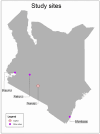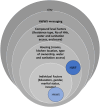Determinants of access to basic handwashing facilities and handwashing with soap in low-income areas of four Kenyan cities
- PMID: 40674324
- PMCID: PMC12270180
- DOI: 10.1371/journal.pgph.0004921
Determinants of access to basic handwashing facilities and handwashing with soap in low-income areas of four Kenyan cities
Abstract
Handwashing with soap is an effective public health measure against infectious disease and is enabled by availability of handwashing facilities, soap and sufficient water. However, access to handwashing facilities in low-income urban areas is often low, which hinders effective handwashing with soap. We assessed access to basic handwashing facilities and handwashing with soap practices in low-income areas across four cities in Kenya. A cross-sectional survey was conducted and observations made at household level to assess availability of basic handwashing facilities. Respondents demonstrated how they usually washed hands and observations were made on whether hands were washed with soap or not. Multivariable logistic regression models were used to assess determinants of access to basic handwashing facilities and of handwashing with soap across the cities. Results show that most handwashing facilities were basins (77%) and customised containers (4.6%). Less than half of respondents (40%) reported always using soap during handwashing and 59% reported sometimes using soap. Those with secondary education had higher odds of having basic handwashing facilities (Adjusted Odds Ratio (AOR)-1.92, P = 0.02, CI 1.14- 3.24) while those without any compound enclosure had lower odds of having handwashing facilities (AOR = 0.42, P = 0.00, CI 0.28-0.62). Respondents with a handwashing facility (AOR = 69.52, P = 0.00, CI 42.88-112.73) and those with a water point in their compound (AOR 2.4, P = 0.00 CI: 1.43-3.98) had higher odds of handwashing with soap. Across the cities, residents from Mombasa had lower odds of having handwashing facilities (AOR = 0.47, P = 0.01 CI 0.28-0.80) and of handwashing with soap (AOR-0.19; P = 0.00; CI 0.08-0.42) compared to those from Nairobi. These results buttress the important role played by water and the presence of a handwashing facility in promoting handwashing with soap. Interventions in low-income areas should focus on increasing access to conditions such as consistent supply of water to promote adequate and sustained handwashing with soap.
Copyright: © 2025 Simiyu et al. This is an open access article distributed under the terms of the Creative Commons Attribution License, which permits unrestricted use, distribution, and reproduction in any medium, provided the original author and source are credited.
Conflict of interest statement
The authors have declared that no competing interests exist.
Figures


References
-
- Wolf J, Hubbard S, Brauer M, Ambelu A, Arnold BF, Bain R, et al. Effectiveness of interventions to improve drinking water, sanitation, and handwashing with soap on risk of diarrhoeal disease in children in low-income and middle-income settings: a systematic review and meta-analysis. Lancet. 2022;400(10345):48–59. doi: 10.1016/S0140-6736(22)00937-0 - DOI - PMC - PubMed
-
- Ross I, Bick S, Ayieko P, Dreibelbis R, Wolf J, Freeman MC, et al. Effectiveness of handwashing with soap for preventing acute respiratory infections in low-income and middle-income countries: a systematic review and meta-analysis. Lancet. 2023;401(10389):1681–90. doi: 10.1016/S0140-6736(23)00021-1 - DOI - PubMed
-
- Wolde M, Abate M, Mandefro G, Beru E, Kassahun A, Tesema GA. Determinants of handwashing practice and its associated factors among mothers of under-5 children in Kolladiba town, Northwest Ethiopia: cross-sectional study. BMJ Open. 2022;12(6):e058960. doi: 10.1136/bmjopen-2021-058960 - DOI - PMC - PubMed
LinkOut - more resources
Full Text Sources
